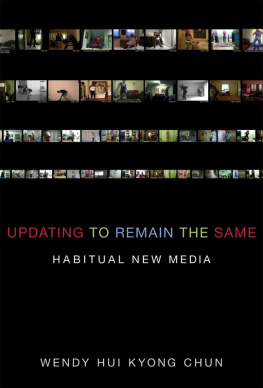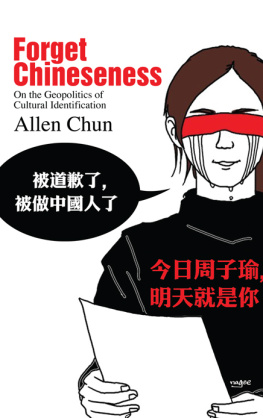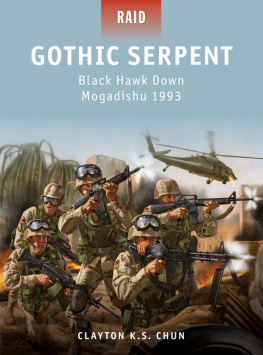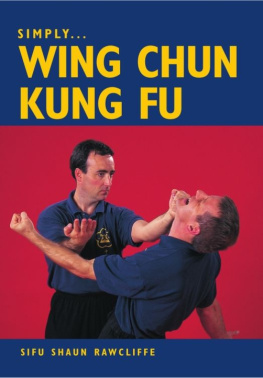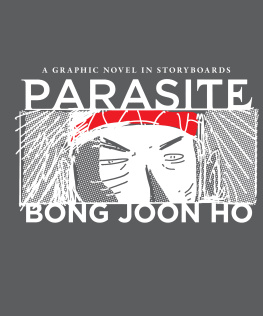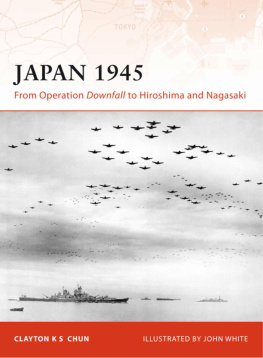Chun - Updating to remain the same : habitual new media
Here you can read online Chun - Updating to remain the same : habitual new media full text of the book (entire story) in english for free. Download pdf and epub, get meaning, cover and reviews about this ebook. year: 2017, publisher: ; London, genre: Politics. Description of the work, (preface) as well as reviews are available. Best literature library LitArk.com created for fans of good reading and offers a wide selection of genres:
Romance novel
Science fiction
Adventure
Detective
Science
History
Home and family
Prose
Art
Politics
Computer
Non-fiction
Religion
Business
Children
Humor
Choose a favorite category and find really read worthwhile books. Enjoy immersion in the world of imagination, feel the emotions of the characters or learn something new for yourself, make an fascinating discovery.
- Book:Updating to remain the same : habitual new media
- Author:
- Publisher:; London
- Genre:
- Year:2017
- Rating:4 / 5
- Favourites:Add to favourites
- Your mark:
- 80
- 1
- 2
- 3
- 4
- 5
Updating to remain the same : habitual new media: summary, description and annotation
We offer to read an annotation, description, summary or preface (depends on what the author of the book "Updating to remain the same : habitual new media" wrote himself). If you haven't found the necessary information about the book — write in the comments, we will try to find it.
Chun: author's other books
Who wrote Updating to remain the same : habitual new media? Find out the surname, the name of the author of the book and a list of all author's works by series.
Updating to remain the same : habitual new media — read online for free the complete book (whole text) full work
Below is the text of the book, divided by pages. System saving the place of the last page read, allows you to conveniently read the book "Updating to remain the same : habitual new media" online for free, without having to search again every time where you left off. Put a bookmark, and you can go to the page where you finished reading at any time.
Font size:
Interval:
Bookmark:
Wendy Hui Kyong Chun
The MIT Press
Cambridge, Massachusetts
London, England
2016 Massachusetts Institute of Technology
All rights reserved. No part of this book may be reproduced in any form by any electronic or mechanical means (including photocopying, recording, or information storage and retrieval) without permission in writing from the publisher.
This book was set in Stone Sans and Stone Serif by Toppan Best-set Premedia Limited. Printed and bound in the United States of America.
Library of Congress Cataloging-in-Publication Data is available.
ISBN: 978-0-262-03449-4
eISBN: 978-0-262-33376-4
10987654321
d_r0
For the members of the Center for Digital Culture in Lneburg, who made this book possible.
For my mother and father, who have made everything possible.
Has the Internet destroyed the world or made it a better place? Does it foster democracy or total surveillance? Community or isolation? Information or pornography? Well-adjusted citizens or homicidal psychopaths?
These questions have been posed and answered over and over again. And they will continue to be so, unless we change our perspective and realizeat the very leastthat the Internet is not just one thing. So, rather than endless debate over whether the Internet is good or bad, this book asks: Why does the Internet evoke such contradictory passions? Its answer: new media are so powerful because they mess with the distinction between publicity and privacy, gossip and political speech, surveillance and entertainment, intimacy and work, hype and reality. New media are wonderfully creepy. They are endlessly fascinating yet boring, addictive yet revolting, banal yet revolutionary.
To understand new medias wonderful creepiness, we need to disabuse ourselves of several assumptions, most importantly that there exists a natural relationship between technology and (the lack of) freedom. Remarkably, the image of the Internet has shifted radically from the mid to late 1990s, when it was seen as cyberspace, an anonymous and empowering space of freedom in which no one knew if you were a dog, to the mid to late 2010s, when the Internet was commonly conceived of as a space of total surveillance or as a privatized space of social media. In both cases, knowing who was a dog and who was not was key (see figure 0a.2).
So, what happened? Did the technology itself change radically? Yes and no. Internet protocol is still basically the same, even if routing, addressing, and storage protocols have changed; but there is no simple relationship between these technical changes and the different imaginaries of the Internet. There is a gap between our perception of communications technologies and their habitual operations. Wireless networking cards, for example, download all the packets they can and then delete what is not directly addressed to them. Users constantly download their neighbors traffic. Given this, why did we ever imagine the Internetwhich is, at its base, a control protocolto be an anonymous space of freedom? Why are networked devices described as personal, when they are so chatty and promiscuous? Further, given the ephemerality of digital information, how has electronic memory become conflated with storage? It takes a lot of workat the very least the U.S. National Security Agency, social media sites that foster cross-platform unique identifiers, and vast server farms that contribute to global climate changeto make the Internet the basis for worldwide surveillance. If the phrase once its there, its there to stay makes any sense, it is because surveillance is now co-produced transnationally by states and private corporations.
To understand the power of our imagined technologies and networks, this book focuses on how they ground and foster habits of using. By focusing on habitsthings that remain by disappearing from consciousnessit reveals the creepier, slower, more unnerving time of new media. Interrogating the hype around disruption, it shows how so-called obsolescent media remain in users bodies. If users now curate their lives, it is because their bodies have become archives. Habit also gets us thinking about the complex relationship between what is allegedly public and private, intimate and social. Habits are things we learn from others, and they make us like others. At the same time, though, they are deeply personal. Working with this contradiction, this book explores the extent to which habits are what society can be in the era of neoliberalism, an epoch that emphasizes individual empowerment and difference. Neoliberal subjects are constantly encouraged to change their habitsrather than society and institutionsin order to become happier, more productive people; to recycle rather than regulate in order to save the world. However, instead of simply bemoaning this situation, this book also asks: Can weby inhabiting the habitualchange society? Further, rather than pushing for a privacy that is no privacya security that fosters insecuritywhat would happen if we demanded more rigorous public rights? If we fought for the right to be exposedto take risks and to be in publicand not be attacked?

Figure 0a.1 Habitual New Media word cloud. Image by Thomas Pringle.
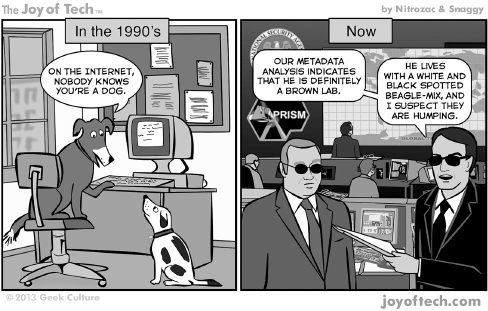
Figure 0a.2 On the Internet, nobody knows youre a dog. Nitrozac & Snaggy, Joy of Tech (2013), http://www.geekculture.com/joyoftech/joyarchives/1862.html. Reprinted with permission.
Research for this book was supported by several grants, leaves, and fellowships. I would like to thank the Institute for Advanced Study (IAS) at Princeton, the Center for Digital Cultures (CDC) and the Digital Cultures Research Lab (DCRL) both in Lneburg, and Brown University for their generous support.
I would also like to thank the many people who have read drafts of this book for their invaluable feedback, in particular the members of the writing groups at the CDC and DCRL, and attendees of seminars at the University of Amsterdam, Brock University, Pitzer College, the Copenhagen Business School, and the University of California at Davis. I am also grateful to the many colleagues and friends who have inspired me at Brown, in Lneburg (Clemens Apprich, Goetz Bachmann, Armin Beverungen, Timon Beyes, Mercedez Bunz, Paul Feigelfeld, Sam Gupta, Claus Pias, Oliver Schultz, Nishant Shah, Madoka Takashiro, Martin and Carmen Warnke, but really everyone), and in Princeton (Danielle Allen, Elizabeth Bernstein, Sherine Hamdy, Amy Kaplan, Karuna Mantena, Camille Robcis, Judith Surkis, and Joan Scott), as well as my constant sources of brilliance: Liz Canner, Florian Cramer, Mary Ann Doane, Kelly Dobson, Lynn Festa, Matthew Fuller, Liza Hebert, Kara Keeling, Susan McNeil, Tara McPherson, Lisa Nakamura, Lisa Parks, Karen Tongson, and Nicholas Mirzoeff. I am indebted to many incredible student assistants who have helped shape this book: Lakshmi Padmanabhan, Ann-Kathrin Wagner, Daniela Wenzlaff, and Thomas Pringle. To the fantastic editorial team at MITDoug Sery, Matthew Abbate, Paula Woolley, Susan Buckley, and Susan ClarkI owe an enormous thanks.
Font size:
Interval:
Bookmark:
Similar books «Updating to remain the same : habitual new media»
Look at similar books to Updating to remain the same : habitual new media. We have selected literature similar in name and meaning in the hope of providing readers with more options to find new, interesting, not yet read works.
Discussion, reviews of the book Updating to remain the same : habitual new media and just readers' own opinions. Leave your comments, write what you think about the work, its meaning or the main characters. Specify what exactly you liked and what you didn't like, and why you think so.

